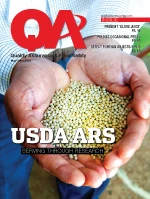One of the reasons that I like working in quality is that every day is different. Operations turns on and runs machines. Warehouse moves product. Accountants check for dollars and cents. Purchasing shops for the best deals and deliveries. Customer Service handles customers. Maintenance fixes things.
But Quality? — We get to do all those things. We work with Operations to assure consistency, track costs of operations, and track the cost of good and poor quality. We work with Maintenance to create a program that prevents breakdowns; and we follow Warehouse so we can track every movement of every ingredient and product. But what about Purchasing? Some companies let them be the secret shopper. They can buy what they want, get it to the plant for on-time use, and everyone is happy. I think all quality practitioners would agree, however, that this is not quite the right way to go about getting the best product to achieve consistent quality and safety.
As a quality professional, I believe we want to be a partner with Purchasing. I call this “minding the Ps and Qs” of the operation. I’ve had the pleasure of working with good and bad purchasers in my career, and the good ones could have been quality practitioners. The good ones partner with Quality so they can buy the right material. They know that the days of buying only on price are gone. Today’s world includes many additional elements that have to be included. Purchasing and Quality work together to define what is to be purchased—the specification. Without the specification for each ingredient, package, or component, Operations cannot achieve product consistency.
Creating Your Specification. So, let’s say you’re not Pepsi or Walmart. You’re a smaller company, and you’re trying to tell a larger supplier what you want to buy. Many times, that supplier has a better idea of the specification that it believes you should be looking for or using. Should you use their spec or develop your own? I think there’s a compromise that can be made on this touchy issue. The supplier knows what it has that will meet your needs, you know what your basic needs are. Certainly you can copy their manufacturing spec and add your details. I think that’s fair and everyone ends up happy.
In many cases, there is a specification already made for you by a regulatory agency or a trade group. For example, you may not have to make your own specification for “Grade AA diced tomatoes.” Take the time to seek out your appropriate trade group and see what it has already done. Your company or an associate of your company is probably a member of these groups, so be sure to take advantage of your membership rights. Many agricultural marketing boards have also developed grading standards. Find the one that fits your need and use that in your specification.
The “Best” Supplier. Now you have a specification, what’s next in your Ps and Qs partnership? I believe both Purchasing and Quality want suppliers who can become an integral part of the entire manufacturing operation. Of course Purchasing starts by looking at those suppliers that can meet the specification. Then they look for the “best” supplier.
What makes the best supplier? Not only do these companies supply the product you specify, they can and have to do so much more in today’s corporate and regulatory environment. This is my favorite part of working with Purchasing. High-quality suppliers not only meet the spec for the product, they are able to readily show you that they do. They will provide a Letter of Continuing Guarantee, a COA with each load, and so much more. Suppliers willing to provide this are assuring you that they are reputable and capable.
Some of the documents buyers request are:
- Product specifications (with storage requirements, nutritional statement, shelf-life expectation, packaging details, etc.).
- Appropriate certifications (Kosher, Halal, Gluten Free, Organic).
- Assurances that they have a quality program (suc as GFSI), food safety program, and are registered with the FDA or appropriate governing body.
- Letter of continuing guarantee.
- Written statement of allergens in (and not in) the product.
- COAs for each delivery.
- Country of origin statement.
- MSDSs (for your plant safety team).
- Explanation of lot codes (so you can manage expiration dates).
The bottom line is that the good suppliers are ready to and capable of providing this information. They also want to provide appropriate customer service. Suppliers have representatives that will help you properly use their product—and they will be there when there is a problem. The best suppliers will become such an important player in your production that you invite them to help you solve product problems. The P and Q here is supplier management.
Supplier Management. A key responsibility of your P & Q team is ensuring that suppliers know where they stand with you. You should routinely give them a report card or evaluation—just like the review you have with your supervisor every year. You tell suppliers how many good things they did, and where they need to improve. How many Supplier Corrective Action Requests (SCARs) did you send them? Did they reply as expected? Were their deliveries on time and complete? Did they provide all documentation requested and required? Were they there for you when you needed them? Work with your Purchasing professional. He or she will usually have access to standard evaluation cards that can be used or modified to fit your grading.
Those are my Ps and Qs: Partner with your Purchasing group to better manage your supply chain. Create and have the best specification. Use the specification as a starting point in working to find the best supplier. Manage your suppliers by letting them know how they’re doing.
If you do this, you’ll be halfway to making a consistent and consistently safe product when all these materials get to manufacturing. Best wishes!

Explore the June 2012 Issue
Check out more from this issue and find your next story to read.
Latest from Quality Assurance & Food Safety
- Nestlé Opens Arizona Beverage Factory and Distribution Center
- Ingredion Invests $100 Million in Indianapolis Plant to Improve Efficiency, Enable Texture Solutions Growth
- Eagle Unveils Redesigned Pipeline X-ray System
- USDA Invests Up To $1 Billion to Combat Avian Flu, Reduce Egg Prices
- Washington Cats Confirmed with HPAI as Investigation into Contaminated Pet Food Continues
- USDA Confirms Bird Flu Detected in Rats in Riverside
- Kyle Diamantas Named FDA’s Acting Deputy Commissioner for Human Foods
- QA Exclusive: Food Safety Leaders React to Jim Jones’ Departure, FDA Layoffs





